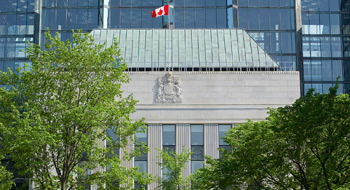
The Bank of Canada is sticking with its key interest rate as it awaits billions in economy-boosting measures expected in the upcoming federal budget.
The central bank kept its trend-setting interest rate locked at 0.5% in its scheduled announcement Wednesday.
The bank’s decision comes as the federal government insists its March 22 budget will include big-ticket spending to help the economy. The Liberals argue the injection, including cash for infrastructure, will contribute to economic growth and create jobs.
The Bank of Canada specifically acknowledged those federal investments, saying it would evaluate the impact of fiscal stimulus measures in its April monetary policy report.
Read: Bank of Canada expected to offer economic outlook in interest rate announcement
Heading into the announcement, there was little expectation of a change to the bank’s overnight rate target. Economists, however, were looking for fresh information as to how it views the state of the economy.
Experts like CIBC’s chief economist noted that the bank appeared to have a goal of saying as little as possible.
“Not only did it leave interest rates unchanged, but it essentially brushed away both any good news and bad news that it’s seen since its January statement,” Avery Shenfeld said.
“Essentially, it’s a decision to wait and see what the federal budget looks like.”
The bank underlined Wednesday that while stubbornly low oil prices continue to hurt the economy, inflation appears on track and that 2015 closed out with better-than-expected growth.
Read: Investor sentiment drops to lowest point since financial crisis: report
It also noted how oil and some commodity prices had rebounded in recent weeks, nudging up the weakened Canadian dollar. Canada-wide employment has held up despite job losses in resources industries and non-energy exports are strengthening, particularly in sectors that benefit from the lower dollar, the bank added.
Financial market volatility, meanwhile, appears to be “abating” and economic growth in the United States has continued to progress as expected, the bank said.
“The global economy is progressing largely as the bank anticipated in its January monetary policy report,” the statement said.
But the Bank of Canada also said financial vulnerabilities have crept higher and the commodity-price slump has left overall business investment “very weak.”
Read: Sounding Board: The link between oil prices and rising disability claims
The Bank of Canada stood pat on its key rate in January after lowering the benchmark twice in 2015.
In explaining the January decision, governor Stephen Poloz said senior bank officials entered pre-announcement deliberations with a bias toward making another cut to the already-low interest rate of 0.5%.
Poloz said despite the weak outlook, the eventual decision to hold firm came after they considered an important factor: the federal government’s promise to pump billions into infrastructure projects.
The Liberal government recently acknowledged next year’s deficit could climb beyond $20 billion amid numerous downgraded economic forecasts – and some observers believe it could reach as high as $30 billion.
Read: Liberals’ deficit continues to climb, reveals Morneau
Shenfeld estimates the Liberal stimulus package could boost Canada’s real gross domestic product by as much as one per cent, though he only expects the economy to really see the benefits in late 2016 and early 2017.
The government has faced flak from political opponents who warn the spending measures will add billions to Canada’s public debt.
In January, the central bank downgraded its 2016 growth projection to 1.4% from its fall forecast of two per cent. At the time, it also predicted the economy to eventually bounce back and expand by 2.4% in 2017.
The anticipated government spending has led many analysts to predict the Bank of Canada will refrain from moving its key interest rate any time soon.
Read: How to cope with low interest rates
“We still believe that the future course of monetary policy will to a large extent hinge on what the federal government will deliver on the fiscal front,” the National Bank of Canada’s Paul-Andre Pinsonnault wrote in a research note to clients.
“But listening to Prime Minister (Justin) Trudeau, it seems that fiscal policy will take the baton allowing the bank to stay on the sidelines.”
The Bank of Canada’s next scheduled rate announcement is April 13, when it will also release its quarterly monetary policy report.
